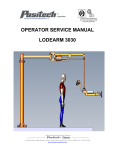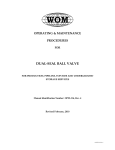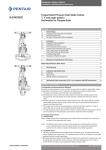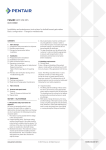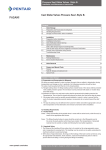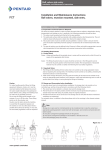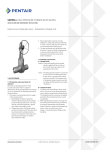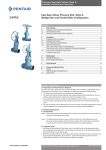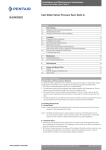Download OPERATOR SERVICE MANUAL
Transcript
OPERATOR SERVICE MANUAL POSITECH CORPORATION 191 N RUSH LAKE ROAD LAURENS, IA 50554 Phone Number: 800-831-6026 24 Hour Service Phone Number: 541-954-2948 Email: [email protected] SERIAL NO: _________ RUN NO: _________ Models Covered: ReactionArm 1000LE LodeArm 3030LE LodeArm 4500LE REV C 26-OCT-15 191 N. Rush Lake Road, Laurens, Iowa 50554 | T. 712.841.4548 | F. 712.841.4765 | www.positech.com NOTES: ………………………………………………………………………………………………………………………… ………………………………………………………………………………………………………………………… ………………………………………………………………………………………………………………………… ………………………………………………………………………………………………………………………… ………………………………………………………………………………………………………………………… ………………………………………………………………………………………………………………………… .………………………………………………………………………………………………………………………… ………………………………………………………………………………………………………………………… ………………………………………………………………………………………………………………………… ………………………………………………………………………………………………………………………… ………………………………………………………………………………………………………………………… ………………………………………………………………………………………………………………………… ………………………………………………………………………………………………………………………… ………………………………………………………………………………………………………………………… ………………………………………………………………………………………………………………………… ………………………………………………………………………………………………………………………… ………………………………………………………………………………………………………………………… ………………………………………………………………………………………………………………………… ………………………………………………………………………………………………………………………… ………………………………………………………………………………………………………………………… ………………………………………………………………………………………………………………………… ………………………………………………………………………………………………………………………… ………………………………………………………………………………………………………………………… ………………………………………………………………………………………………………………………… ………………………………………………………………………………………………………………………… ………………………………………………………………………………………………………………………… Table of Contents SECTION 1 - NAMING CONVENTION AND SERIAL TAG................................................................................... 1 A. NAMING CONVENTION .............................................................................................................. 1 B. SERIAL TAG LOCATION AND NOMENCLATURE ...................................................................... 2 SECTION 2 - SPECIFICATIONS .......................................................................................................................... 3 A. MECHANICAL SPECIFICATIONS ............................................................................................... 3 B. PNEUMATIC SPECIFICATIONS: ................................................................................................. 3 C. HYDRAULIC SPECIFICATIONS .................................................................................................. 3 D. ELECTRICAL SPECIFICATIONS................................................................................................. 3 E. AERIAL NOISE ............................................................................................................................ 3 F. ENVIRONMENTAL CONDITIONS ............................................................................................... 3 G. PEDESTAL MOUNTING PATTERN ............................................................................................. 4 H. OVERHEAD SPACER MOUNTING PATTERN ............................................................................ 4 I. CONCRETE MOUNTING GUIDELINES....................................................................................... 5 J. SOIL CONDITION: ....................................................................................................................... 5 K. FULLY REINFORCED CONCRETE FLOOR CONDITION............................................................ 5 L. POURED FOUNDATION CONDITION ......................................................................................... 5 M. PLATING ON CONCRETE........................................................................................................... 5 SECTION 3 - INSTALLATION INSTRUCTIONS................................................................................................... 6 A. PALLET INFORMATION .............................................................................................................. 6 B. PEDESTAL INSTALLATION ........................................................................................................ 7 C. SPACER INSTALLATION ............................................................................................................ 8 D. LIFTING WITH A FORK TRUCK .................................................................................................. 9 E. ATTACHING MANIPULATOR TO PEDESTAL ........................................................................... 10 F. ATTACHING MANIPULATOR TO SPACER ............................................................................... 11 G. PREPARING THE PRIMARY ARM FOR LEVELING .................................................................. 13 H. LEVELING THE PRIMARY ARM – DRIFT METHOD.................................................................. 14 I. PREPARING THE LIFT ARM FOR LEVELING ........................................................................... 15 J. LEVELING THE LIFT ARMS ...................................................................................................... 16 K. SETTING THE ROTATION STOPS ........................................................................................... 17 L. BALANCE CONTROL ADJUSTMENTS ..................................................................................... 19 M. METERING CONTROL ADJUSTMENTS ................................................................................... 20 SECTION 4 - MAINTENANCE, ADJUSTMENTS, & INSPECTIONS................................................................... 21 A. AIR LINE SIZING FOR SUPPLY AIR ......................................................................................... 24 SECTION 5 - TROUBLESHOOTING .................................................................................................................. 25 APPENDIX A: MACHINE OPERATION PROCEDURE .......................................................................................... APPENDIX B: DRAWINGS, SPARE PARTS LIST ................................................................................................. SECTION 1 - NAMING CONVENTION AND SERIAL TAG A. NAMING CONVENTION Primary Arm Main Post Drag Brake Middle Joint Brake Adjustable Rotation Stop (Option) Lift Arm Lift Cylinder Pedestal (Option) Main Post Rotation Stop (Option) Middle Joint End Joint Down Shaft Anchor Bolt & Leveling Jacks (Option) 1 B. SERIAL TAG LOCATION AND NOMENCLATURE Model Number Capacity of Base Machine Only Serial Number – PROVIDE FOR SERVICE SUPPORT (shown on cover) Weight of Tooling Electrical Voltage/Hertz/Phase Electical Amps Air PSI Air SCFM Design Category Service Class Serial Tag Location 2 SECTION 2 - SPECIFICATIONS A. MECHANICAL SPECIFICATIONS See Profile Drawing for specification. Equipment reach and load limit specifications are identified on the Profile Drawing supplied with specific projects. This view will include application lift, and mounting configurations identified and supplied at time of sale. B. PNEUMATIC SPECIFICATIONS: See Profile Drawing for specification. C. HYDRAULIC SPECIFICATIONS See Profile Drawing for specification. D. ELECTRICAL SPECIFICATIONS See Profile Drawing for specification. E. AERIAL NOISE Level of continuous acoustic pressure: <80 dB (A scale) Aerial noise measurements are taken at the operator’s work position and based on a 50th percentile operator’s height. See Profile Drawing for special notes. F. ENVIRONMENTAL CONDITIONS The manipulator is designed to operate inside a protected site from outside environmental conditions. The operating environment needs be free of aggressive contaminants, acids, corrosive gases, salts, etc. Operating Temperature: 50°F – 120°F [10°C – 49°C] Relative Humidity: <95% See Profile Drawing for special notes. 3 G. PEDESTAL MOUNTING PATTERN H. OVERHEAD SPACER MOUNTING PATTERN 4 I. CONCRETE MOUNTING GUIDELINES It is solely the customer’s responsibility to provide the proper foundation for the manipulator and if conditions are questionable or concrete does not look adequate the customer needs to consult a qualified professional to inspect and make recommendations. J. SOIL CONDITION: The minimum soil condition that must also be achieved is 2500 lbs/sq ft [0.12 MPa]. K. FULLY REINFORCED CONCRETE FLOOR CONDITION • 6 in [152mm] thick • 3500 psi [24.1 MPa] compressive strength • No cracks within 48in [1.2m] radius of pedestal L. POURED FOUNDATION CONDITION Foundation dimensions: 66” X 66” X 18” M. PLATING ON CONCRETE Contact Positech for drawings or ordering information. 5 SECTION 3 - INSTALLATION INSTRUCTIONS A. PALLET INFORMATION Inspect manipulator for any signs of damage due to shipping. Document damage and make any claims to the carrier. MANIPULATOR AS SHIPPED FROM POSITECH: Do not cut manipulator banding. Refer to LIFTING WITH A FORK TRUCK for installation instructions. Shipping pallet Fork truck pockets 6 B. PEDESTAL INSTALLATION LEVEL PEDESTAL BEFORE INSTALLING MANIPULATOR ON PEDESTAL (See LEVELING THE PRIMARY ARM for leveling the manipulator if it is already installed on pedestal.) Refer to CONCRETE MOUNTING GUIDELINES for concrete guidelines before mounting pedestal. Review profile drawing for torque requirement. 1. Set pedestal over area and drill holes using pedestal for template. Locate pedestal so airline can be routed through air supply hole. 8. Torque the anchors. 2. Move pedestal and clean holes with compressed air and nylon brush. 3. Add 1 flat washer between concrete and pedestal for each jack. 4. Assemble anchor with washer, lock washer, and nut below anchor bolt chamfer and drive in with hammer. 7. Tighten the jam nuts on jacks against pedestal flange. 5. Torque anchor to seat anchor. Then loosen. 6. Level pedestal by adjusting the leveling jacks. Use a machinist’s level to check in two directions perpendicular to each other. FINAL NOTES: • No grouting is required to mount this pedestal. Re-torque this pedestal one week after install. Re-torque pedestal according to suggested maintenance schedule. 7 C. SPACER INSTALLATION LEVEL SPACER BEFORE INSTALLING MANIPULATOR ON SPACER: (See LEVELING THE PRIMARY ARM for leveling the manipulator if it is already installed on spacer.) Review profile drawing for torque requirement. 1. Install jack and jam nut. 2. Install flat washer and lock nuts if necessary. 6. Tighten the bolts. 3. Loosen the jam nut for leveling 7. Tighten the jam nuts against spacer. 4. Loosen the bolts enough to level spacer. 8. Re-check levelness of spacer to make sure it is still level 5. Level spacer by adjusting the leveling jacks. Use a machinist’s level to check in two directions perpendicular to each other. 8 D. LIFTING WITH A FORK TRUCK The manipulator is palleted to allow for easy installation with a fork truck. Raise the pallet above the pedestal and lower the manipulator onto the pedestal and install as shown in ATTACHING MANIPULATOR TO PEDESTAL For overhead mount, simply raise the pallet up until the manipulator mates with the mounting surface. See ATTACHING MANIPULATOR TO SPACER for installation details. 9 E. ATTACHING MANIPULATOR TO PEDESTAL Lift manipulator as shown in LIFTING WITH A FORK TRUCK. 10 Run air line through hole in pedestal and connect to nipple. Lower manipulator until bearing housing mates to pedestal. Torque machine mounting bolts. See profile drawing. F. ATTACHING MANIPULATOR TO SPACER Lift manipulator until bearing housing mates to spacer Run air line through hole in spacer and connect to nipple. Lift manipulator as shown in 11 Torque machine mounting bolts. See profile drawing. LIFTING WITH A FORK TRUCK 12 G. PREPARING THE PRIMARY ARM FOR LEVELING All adjustments of the primary arm will be accomplished by adjusting the leveling jacks or shimming under the primary bearing housing. 1. Position lift arm under primary arm. If lift arm will not go under primary arm position lift arm straight out from primary arm. 2. Loosen primary arm brake caliper to allow primary arm to rotate freely. 13 H. LEVELING THE PRIMARY ARM – DRIFT METHOD 1. Select any of the four positions shown such as position A and rotate the primary arm into that position. Release arm and step back so that any "drift" (movement to the left or the right) of the primary arm can be noted. 2. To correct for drift, loosen the anchor bolts at the base and extend the levelling jacks on the side of the pedestal base plate that the arm drifted toward. 3. Re-tighten anchor bolts and return arm back to position A and repeat steps 1 & 2, if drift still occurs. 4. When all drift has been removed from position A, rotate primary arm 180 degrees to position B and repeat steps 2 & 3. 5. When all drifts have been removed from position B, rotate primary arm 90 degrees to position C and repeat steps 2 & 3. 6. When all drift has been removed from position C, rotate primary arm 180 degrees to position D and repeat steps 2 & 3. This completes the levelling of the primary arm. Position D Position B Position A Position C 14 I. PREPARING THE LIFT ARM FOR LEVELING Leveling adjustments to the lift arm do not affect the alignment of the primary arm. 1. Tighten primary caliper brake to prevent primary arm from rotating. . 3. Rotate lift arm parallel to primary arm 2. Loosen middle joint brake caliper to allow lift arms to rotate freely. Leveling adjustments to the lift arm are performed by loosening or tightening the adjustment bolts in the adjusting collar. Adjustment bolts Primary Bearing Housing Primary Arm 15 J. LEVELING THE LIFT ARMS 1. 2. 3. 4. 5. 6. Select a position such as B and rotate the lift arm into that position. Release arm and step back so that you can note any drift of the lift arm. If any drift occurs, tighten the adjustment bolt or bolts, on the side that the arm drifted towards, while at the same time loosening the adjustment bolt or bolts, on the side opposite of the bolt or bolts being tightened. Repeat steps 1 & 2 to check for any additional drift. After all drift has been eliminated from position B, rotate lift arm 90 degrees to position C and repeat steps 1, 2 & 3. After all drift has been eliminated from position C, rotate lift arm 180 degrees to position D and repeat steps 1, 2 & 3. This completes the levelling of the lift arm. Re-adjust the primary arm brake (and middle joint brake, if applicable) to fit your requirements. Position D Position A Position C 16 K. SETTING THE ROTATION STOPS Rotation stops may be supplied for the main post and middle joint rotation axis. Set the rotation stops to allow the proper working range for the manipulator. 1. 2. 3. 4. 5. 6. Rotate arm to stop position Slide rotation stop onto brake disk with bumper located against caliper brake support Tighten set screws to set stop location Use 3/8 transfer punch to locate drill holes through center of the set screw Drill ø0.266 holes thru brake disk Tighten bolts, washers, and lock nuts Main Post Rotation Stop Middle Joint Rotation Stop Shoulder bolt and washer Set screw Brake Disk Slot Lock Nut 17 The middle joint had holes pre-drilled to allow the lift arms to rotate equally in both directions. The rotation stop can be moved to allow the lift arms to be stored under the primary arm. If the middle joint rotation stop is moved, the lift arms may be able to contact the primary arm if the operator moves the lift arms into the contact zone. Use caution when relocating the middle joint rotation stop to keep the hoses routed around the middle joint from being wrapped around the joint. If two rotation stops are supplied for the middle joint, it may be useful to set one stop so the lift arm cannot rotate past center. This is useful if the lift arms are used in one quadrant of rotation. Lift Arm Rotation Direction Second Rotation Stop 18 L. BALANCE CONTROL ADJUSTMENTS See the pneumatic schematic for specific information regarding the pneumatic components used. CONNECTING THE SUPPLY AIR 1. 2. 3. Set the system pressure regulator to zero. Connect supply air. Verify pressure and flow requirements listed on profile drawing. Adjust system pressure regulator to requirement shown on profile drawing. LOAD & NO LOAD BALANCE REGULATORS If there is a bias circuit or a payload is lifted, there are two balance regulators. The regulators are labeled accordingly. 1. 2. Set the “No Load” balance regulator with the empty tool. Set the “Load” or “Bias” balance regulator with the tool and payload or with the bias switch actuated. WARNING: The “Load” adjustment will need to be reset if the payload weight changes. The “No Load” adjustment will need to be reset if the tool weight changes. Use the following steps to set the “Load” and “No Load” balance regulators. 1. 2. 3. 4. 5. Fully unscrew the “No Load” balance regulator. With only the tool weight, carefully adjust the “No Load” regulator until the tool does not drift up or down. Fully unscrew the “Load” balance regulator. Make sure the “Load” or “Bias” switch is activated. Add the payload to the tool and carefully adjust the “Load” regulator until the tool and payload does not drift up or down. LOCK OUT PROCEDURE FOR BALANCE CONTROL 1. 2. 3. Remove payload from tool and lower tool to lowest position. Set the system pressure regulator to zero. Lockout per factory procedure. WARNING: The machine is not in a zero energy state. There may be pressure trapped in any cylinder with a lock valve due to the lock valve minimum locking pressure. If a zero energy state is required, cylinder lock valves need to be piloted by an external air source and some air lines may need to be removed. See pneumatic schematic for more details and consult Positech with additional questions. 19 M. METERING CONTROL ADJUSTMENTS See the pneumatic schematic for specific information regarding the pneumatic components used. CONNECTING THE SUPPLY AIR 1. 2. 3. Set the system pressure regulator to zero. Connect supply air. Verify pressure and flow requirements listed on profile drawing. Adjust system pressure regulator to requirement shown on profile drawing. LOCK OUT PROCEDURE FOR METERING CONTROL 1. 2. 3. Remove payload from tool and lower tool to lowest position. Set the system pressure regulator to zero. Lockout per factory procedure. WARNING: The machine is not in a zero energy state. There may be pressure trapped in any cylinder with a lock valve due to the lock valve minimum locking pressure. If a zero energy state is required, cylinder lock valves need to be piloted by an external air source and some air lines may need to be removed. See pneumatic schematic for more details and consult Positech with additional questions. 20 SECTION 4 - MAINTENANCE, ADJUSTMENTS, & INSPECTIONS Maintenance, adjustments, and inspections fall into three categories: every lift, frequent, and periodic. • Every lift evaluations: are visual examinations completed by operator before and during each lift. • Frequent evaluations: are visual examinations completed by the operator or designated persons with records not required. The period to complete these evaluations is based on a service rating of normal (monthly), heavy (weekly), or severe (daily) as explained below. • Periodic evaluations: are visual examinations completed by qualified personnel completing records of apparent external condition to provide a basis for continuing evaluation. The period to maintain these records is based on a service rating of normal (yearly), heavy (semiannually), or severe (quarterly) as explained below. Normal Rating Heavy Rating Severe Rating Below 65% of rated load 65% to 100% of rated load At 100% of rated load Operate in an industrial environment free of aggressive contaminants Life of manipulator is 2,000,000 cycles Operate in an industrial environment free of aggressive contaminants Life of manipulator is 1,000,000 cycles Operate in abnormal environment Life of manipulator is 500,000 cycles For a manipulator that is outside these conditions refer to the profile drawing and/or consult the factory for specific instructions. EVERY LIFT EVALUATIONS • Remove excess debris from surface of the load. • Verify grip pad or vacuum cup is free of contaminant. Replace if excessively worn. • Check the condition of the operator’s controls and gauges on controls • Verify the load is secure after actuation of tooling and before moving the manipulator. 21 FREQUENT EVALUATIONS • Move the manipulator in and out and around each axis and check for free motion. Check bearing seals for leakage or damage. Replace any bearings that need to be replaced. • Check friction devices, linkages, and other mechanical parts for excess wear and replace as needed. Check drag brake pucks for excessive wear. • Check welds on structural members for cracks. Look for cracked or missing paint over a weld. If welds are torn from the base steel, cracked, or broken the manipulator should not be used until repaired or determined safe. Consult factory for solution. • Check structural members for deformations. Consult factory for solution. • Check pivoting points and hook points for excessive wear and replace as needed. • Replace missing guards, fasteners, covers, stops, decals, warning labels, or nameplates. • Check for loose fasteners, especially set screws, and retighten. • Check for leaks. Inspect condition and routing of all external hoses. Replace any leaky components or cracked hoses. • Operating the manipulator: Check that all functions are in adjustment, that all automatic mechanisms functions properly, and that no functions interfere with current operation of the work cell. PERIODIC EVALUATIONS • Complete the frequent evaluations along with the following evaluations. • Check anchor bolts and re-torque. See PEDESTAL INSTALLATION for detailed views. • Check air supply to manipulator. See profile drawing for required pressure and flow. • Check spacer mounting bolts if overhead mounted and re-torque. SPACER INSTALLATION for detailed views. • Check main post mounting bolts and re-torque. See 22 • • • • • • • • • • ATTACHING MANIPULATOR TO PEDESTAL for detailed views. Check for worn or cracked gears, pulleys, sheaves, sprockets, bearings, chains, or belts and replace as needed. Check manipulator for level both in/out and around the main post and end joint. If the manipulator is level, the manipulator will not wander or wander very little. See LEVELING THE PRIMARY ARM for leveling the manipulator to eliminate drift in all operating quadrants. Inspect lift cylinder pilot check valves. Inspect check valves on grip cylinder or vacuum check valves. Check GSC adjustment. Use empty tool and adjust GSC knob until an audible pop is heard. Screw in adjustment ¼ turn and tighten jam nut. Verify adjustment using a scrap part. 23 A. AIR LINE SIZING FOR SUPPLY AIR Note: See profile drawing for required flow and pressure. SCFM Length of run in feet, Air line size in inches FLOW 25 50 75 100 150 200 300 500 1000 6 ½ ½ ½ ½ ½ ½ ½ ¾ ¾ 18 ½ ½ ½ ¾ ¾ ¾ ¾ 1 1 30 ¾ ¾ ¾ ¾ 1 1 1 1¼ 1¼ 45 ¾ ¾ 1 1 1 1 1¼ 1¼ 1¼ 60 ¾ 1 1 1 1¼ 1¼ 1¼ 1½ 1½ 90 1 1 1¼ 1¼ 1¼ 1¼ 1½ 1½ 2 120 1 1¼ 1¼ 1¼ 1½ 1½ 1½ 2 2 150 1¼ 1¼ 1¼ 1½ 1½ 2 2 2 2½ SLM Length of run in meters, Air line size in mm FLOW 7.5 15 25 30 45 60 90 150 300 150 13 13 13 13 13 13 13 19 19 500 13 13 13 19 19 19 19 25 25 580 19 19 19 19 25 25 25 32 32 1250 19 19 25 25 25 25 32 32 32 1700 19 25 25 25 32 32 32 38 38 2500 25 25 32 32 32 32 38 38 51 3400 25 32 32 32 38 38 38 51 51 4200 32 32 32 38 38 51 51 51 64 24 SECTION 5 - TROUBLESHOOTING 5. Grip release without being supported A. Check GSC setting B. If used, check 6 passage rotary manifold for leaks C. Verify proper hose connections D. Check bleed down speed 6. Oil discovered on machine A. Check lost load cylinder for leaks B. Check hydraulic lines to brakes C. Verify FRL lubricator is not set too high D. Check FRL 7. Up/Down movement difficult A. Check balance regulator adjustment B. Verify horizontal arms are not rubbing on lift housing C. Check lift cylinder and muffler D. Check lost load cylinder E. Check vertical cam eccentrics F. Verify supply pressure and sufficient flow 8. Rotation drift at tooling A. Check main post level B. Check anchor bolts on main post C. Check middle joint leveling 1. Machine does not move up or down A. Check main air supply B. Verify lost load cylinder isn’t locked C. Check main regulator D. If used, check lift cylinder on/off switch E. Check pilot to lock valve F. Check lock valve 2. Drifts up A. Check metering valve for leaks B. Check GSC valve for leaks C. If used, check 6 passage rotary manifold for leaks D. Check balance setting E. Check minimum lift setting F. Check tool balance adjustment setting 3. Drifts down A. Check metering valve B. If used, check 6 passage rotary manifold for leaks C. Check for leaky lift cylinder seal, blocking valve connection D. Check white poly lines for leaks 4. Main post rotation difficult A. Check for main post bearing wear B. If used, check drag brake adjustment C. Check rails on trolley systems 25 APPENDIX A: MACHINE OPERATION PROCEDURE APPENDIX B: DRAWINGS, SPARE PARTS LIST































